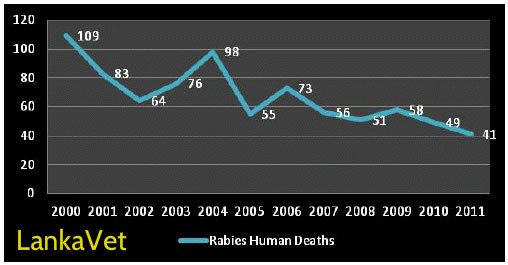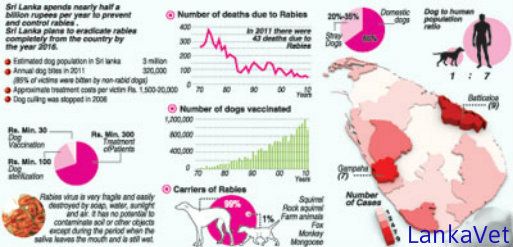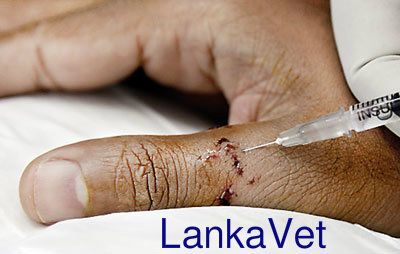
Rabies was back in the news with the
Health Minister Maithripala Sirisena creating an uproar, especially among
animal lovers and animal rights activists when he said Sri Lanka had decided to
lift a moratorium on killing of stray dogs as the government attempted to
tackle the problem of 2,000 people being admitted daily to hospital after being
bitten.
 The law here allows authorities to catch
and kill stray animals, but a presidential order stopped the practice in 2006
following lobbying by animal rights groups. The health minister said the stray
dog population was currently three million and was increasing rapidly due to
poor sterilization programmes in some areas of the country.
The law here allows authorities to catch
and kill stray animals, but a presidential order stopped the practice in 2006
following lobbying by animal rights groups. The health minister said the stray
dog population was currently three million and was increasing rapidly due to
poor sterilization programmes in some areas of the country.
However, in the face of concerns raised by
animal rights activists, the Minister said that he wiil issue orders to health
officials in local authorities to control the stray dog population through
sterilizing programmes.
“Rupees one billion has been allocated for
rabies control this year. A survey will be conducted and all dogs that have
owners will be given collars. Not a single dog will be killed but a wide
sterilization programme will take place with the help of the private sector,”
he said. Against this backdrop, health officials have warned that “community
dogs” or dogs loitering in public places are the latest addition to the
country’s dog population, contributing to the increasing number of rabies
cases.
 Dr. Amila Gunasekare, Medical Officer in
Charge of National Hospital’s Anti-Rabies Unit said apart from stray dogs and
domesticated dogs, there has been an increase in the number of attacks from community
dogs which shelter in public places.
Dr. Amila Gunasekare, Medical Officer in
Charge of National Hospital’s Anti-Rabies Unit said apart from stray dogs and
domesticated dogs, there has been an increase in the number of attacks from community
dogs which shelter in public places.
“People dump unwanted pups in the premises
of temples, hospitals, schools, police stations and other public areas. The
dogs are fed but only a few bother to sterilize or neuter them. This is a
growing menace,” he said.
Emphasizing the problem, he said a number
of inmates at the Angoda Mental Hospital had received treatment after being
bitten by dogs dumped in the hospital premises. “We have attended to patients
who have been bitten while at school, at police stations and temples,” Dr.
Gunasekare said.
Rabies is a viral disease that is
transmitted from the saliva of any mammal, but mainly through dog bites. It is
invariably fatal in both humans and mammals. It is reported worldwide that
approximately 45% of rabies deaths occur in Asia, with dog bites accounting for
96% of human rabies cases worldwide.
The virus in general spreads through
bites, scratches and licking of mucus membrane or an open wound. In Sri Lanka,
the majority of the cases are from dog bites followed by cat bites and scratches.
Currently, Sri Lanka’s ratio of dogs to human population is 1:6.
A victim of a dog bite being attended to
According to officials, in 2011, the
Government spent Rs. 300 million on treating rabies victims, Rs. 30 million on
Rabies vaccines and Rs. 100 million on the sterilization or neuter of dogs. A
patient who is infected is given the Anti-Rabies Vaccine (ARV) and those with
severe bites are given both the vaccine and serum, human rabies immunoglobin
(human blood
serum) or horse blood serum.
The human blood serum mainly imported from Germany costs Rs.
6,000- 7,000 per vial while the imported horse serum from India is between Rs.
1500-Rs.2000 but sometimes cause allergic reactions.
About 100,000 anti-rabies serum vials are
imported from Germany, France and India. On average a person needs at least four
or five vials of human blood serum as against only two vials of horse serum for
the treatment of a bite.
“Sri Lanka is the only country that gives
anti-rabies medicines free. Because of the high cost we first try to treat with
horse serum. If the patient suffers from allergic reactions, he is given
anti-histamines and later treats with human blood serum. Those who do not want
to go through this process can purchase the human rabies immunoglobin from
outside,” he said.
Commenting on the disease, Dr. Gunasekare
said the points from which the virus enters the body most rapidly are through
nerve-rich areas like fingertips, face and lips.
Dr. P.L.A. Harischandra
 Meanwhile, Public Health Veterinary
Services Director Dr. P L A Harischandra said, 1500 dog bites are reported daily
in Sri Lanka.
Meanwhile, Public Health Veterinary
Services Director Dr. P L A Harischandra said, 1500 dog bites are reported daily
in Sri Lanka.
“In 2011, 320,000 dog bites were reported
and 43 persons died of rabies. The government spent Rs: 300 million on
anti-rabies treatment. Vaccinating is done mostly by the private sector and
about Rs: 800.00 is spent on one dog,” he said.
“The main reason for the increase in rabies is irresponsible pet ownership. Owners of pets should make sure that their pets are well taken care of,” he said. According to official statistics, Gampaha and Galle districts have recorded the
highest number of rabies cases.

Sagarika Rajakarunanayake, president of
‘Sathva Mithra’, an animal welfare organization said, sterilization programmes
conducted by the government authorities have not been successful as there was
no proper monitoring.
 “The 1893 law of culling stray dogs has
brought no results. The only viable method is scientific and humane dog
population control and vaccination,” she said. Animal welfare organizations in
a joint statement said that the eradication of rabies would call for at least
70 percent of the dogs being vaccinated (both owned and stray).
“The 1893 law of culling stray dogs has
brought no results. The only viable method is scientific and humane dog
population control and vaccination,” she said. Animal welfare organizations in
a joint statement said that the eradication of rabies would call for at least
70 percent of the dogs being vaccinated (both owned and stray).
They suggest a survey of dogs being done
followed by registration and identification of owned dogs and a vaccination and
sterilization program that covers 80 percent of dogs . They also added that
rabies awareness programs be conducted at schools and on a community level
while legislation be introduced on responsible pet ownership and garbage
control strategies be implemented.
Community dogs dumped in public places is a problem
 “Another area of public responsibility and
co-operation is not to feed dogs in a haphazard way and to throw your left over
food. It is best to dispose of leftover food in a responsible manner. Where
there is no food, no dog will spend time there,” the statement said. The
organizations are also against the government’s plan to allocate a plot of land
for stray dogs.
“Another area of public responsibility and
co-operation is not to feed dogs in a haphazard way and to throw your left over
food. It is best to dispose of leftover food in a responsible manner. Where
there is no food, no dog will spend time there,” the statement said. The
organizations are also against the government’s plan to allocate a plot of land
for stray dogs. “The reality of most shelters in countries
like ours is that they provide very poor welfare conditions. The dogs are often
overcrowded, not fed adequately, cages not cleaned often enough, inadequate
human interaction and personal attention. As a shelter does not address the
root cause of the problem of why there are dogs on the street and because it
does nothing to encourage responsible dog ownership and civic responsibility,
it does not lead to either dog population reduction or rabies control.”
“The reality of most shelters in countries
like ours is that they provide very poor welfare conditions. The dogs are often
overcrowded, not fed adequately, cages not cleaned often enough, inadequate
human interaction and personal attention. As a shelter does not address the
root cause of the problem of why there are dogs on the street and because it
does nothing to encourage responsible dog ownership and civic responsibility,
it does not lead to either dog population reduction or rabies control.”
No comments:
Post a Comment